While preparing a Western juniper for exhibit, I became curious as to why the tree was planted so far to one side of the pot. I was somewhat concerned because I couldn’t show the tree as it appeared below.
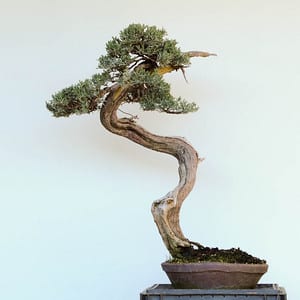
Western juniper
My worry was that all of the roots came from a single spot at the far end of the pot. After removing the tree from pot, I learned that the roots were healthy.
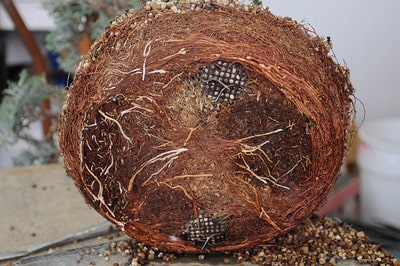
Western juniper roots – note new growth in December
The mystery would wait for a few minutes – first I had to prepare the pot. The pot was made by Michael Hagedorn and has a number of features that make it bonsai friendly.
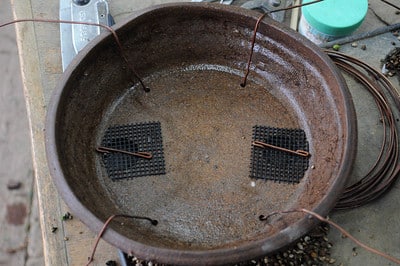
Wired pot from above
Note below the recessed areas on the bottom of the pot for the wire. Note also the recessed area mid-way along the grooves. It’s designed to make room for wire cutters. A number of bonsai pots have similar grooves but no easy way to get to the wires. This can make removing them a challenge. If you find a pot with such grooves, you can avoid future trouble by running the wires perpendicular to the grooves.
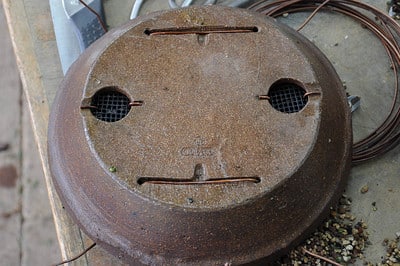
Wired pot from below
Once the pot was ready, I combed out the roots. There were plenty after just one year of growth.
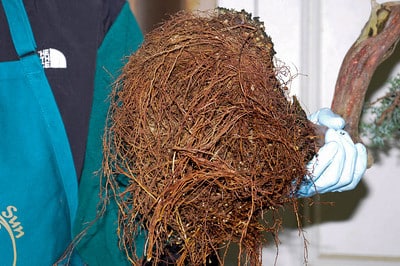
After combing the roots
I clipped away the roots that hung down and found the large root that forced the tree to the side of the pot. I removed a fair chunk of it.
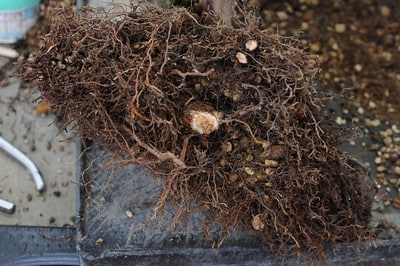
Large root distil from the trunk
I combed out the sides and top of the rootball and was left with an odd shape to work with. The rootball was high on one side and low on the other; flush with roots on the right and devoid of roots on the left. The tree was tippy – some engineering would be required to secure it in the pot.
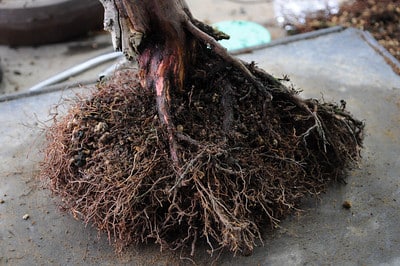
Rootball prepared
The solution Boon and I came up with used a block of wood, an extra wire, and a chopstick. Unorthodox, yet effective.
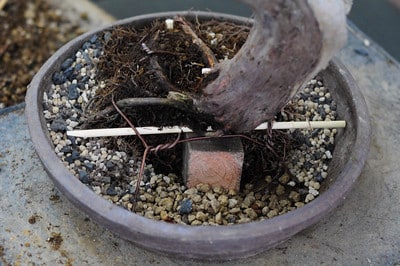
Tree secured
An extra bit of chopstick held the distil wire snug. After working the soil between the roots, the tree stayed put.
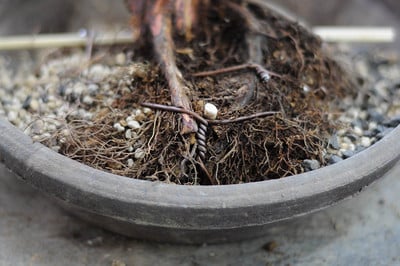
Chopstick to keep tie-wire in place
A few weeks after repotting I prepared the tree for exhibit – what a difference.
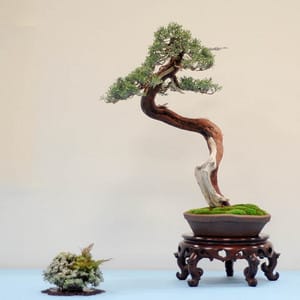
Tree and accent as displayed at BIB’s 11th annual exhibit
Although the result was an improvement, I expect an even bigger gain when I repot next year. I’d like to center the tree in the pot and rely more on new roots growing on the left side of the trunk. I’m looking forward to the work – every little bit helps.
Subscribe to Bonsai Tonight
New Posts Delivered Every Tuesday and Friday
Scott Straley says
Jonas,
I recalled seeing this tree on your blog, and I really liked it, so I went looking and found it back in July and December ’09. I think you’ve really moved it along in the right direction, and the foliage is really taking great shape. Keep up the good work.
Scott
Jack says
Hello Jonas,
Lovely sequence on this juniper. I am wondering where you found the jiita for the accent plant. I’ve had tough luck finding one. Regards, Jack.
xwires says
Thanks Jack – I’ve found them tough to find as well. I bought this one in Japan at the Green Club at Kokufu several years back. It’s one of the items I try to buy whenever I get to Japan. There’s likely a good importer who can supply jiita, but I’ve yet to find it.
Actually last year at Kokufu it was harder to find these than I expected. There was only one vendor selling similar jiita but they were very expensive. I’ll be curious to learn if anyone knows of a good source for them.
Bruce winter says
Here’s one source for jiita: http://bonsai.ocnk.net/product-list/4
Yes, a bit dear, why isn’t someone making them in the west?
Ben Vinocour says
Great solution for a difficult re-pot! Were you and Boon at all worried about the block of wood holding too much moisture over time and affecting the roots in the immediate area? Did you consider using stone or something else non-porous?
Ben
xwires says
Hi Ben – good question. We’ve been using blocks of wood and chopsticks for years without issue. Most trees are repotted within a few years which gives us time to switch out the wood before it rots. In many cases, new roots can support the tree and the blocks are no longer necessary. I typically only use stone to balance a tippy tree when necessary, in addition to tying the pot to a concrete block.